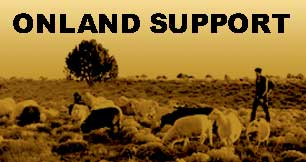Navajo says evictions of farmers from urban farm sends a message
June 19, 2006 by pathfinder
Filed under Archives
by Brenda Norrell, Indian Country Today 06.19.06
LOS ANGELES – Indigenous and others who have been growing food in
downtown Los Angeles’ South Central Farm for a decade, faced off with
sheriff’s deputies as they were evicted to make room for a warehouse.
Actress Daryl Hannah and others climbed into a walnut tree or chained
themselves to concrete-filled barrels and were arrested.
Klee Benally, Navajo from Arizona, was at South Central Farm and said
the creation of this oasis – an urban garden – and the arrests and
evictions should send a signal to Indian country and the nation.
”The South Central Farm is an environmental and cultural oasis in
the midst of Los Angeles. Many of the farmers who have been
cultivating the fields that I met there are indigenous peoples from
Central America,” Benally told Indian Country Today.
”For years prayers have been offered on this land; there were
visible altars and many herbs for healing. I offered my prayers as
well.”
It is believed to be the nation’s largest urban garden, where corn,
squash and nopal cactus were among the crops growing in abundance –
enough to feed families. Preparing for the sheriff’s raid, families
cooked nopales quesadillas and listened to a Norteno band play.
At daybreak on June 13, 120 deputies, many armed with batons and riot
helmets, served an eviction order signed by a judge in May. Deputies
used saws to cut down the chain-link fence around the site, according
to The Associated Press.
Inside the garden, firefighters cut free protesters who chained
themselves to the walnut tree, barrels filled with concrete and a
picnic table. Deputies slowly pulled people out from among the
avocados, sunflowers and other produce.
Benally said families were growing here, along with food.
”When you destroy the means of self-sufficiency, you destroy the
people; and that is not just happening to indigenous farmers in south
central Los Angeles, but all over the world. Destroying a farm
doesn’t just destroy the plants and food, it destroys the culture as
well.
”What is offered in the farm’s place? Certainly the 350 farmers as
well as community members rely on the food they cultivated here. Now
what will they eat, food with low nutritional value from the shelves
of a corporation?
”How will their children learn where their food comes from and their
indigenous cultural heritage?”
Benally said the farmers’ evictions reflects what is happening at Big
Mountain on the Navajo Nation in Arizona, where Navajos have resisted
forced relocation for 30 years as Peabody Coal Co. expanded coal
mining and used aquifer water to slurry coal.
Further, Klee said it reflects the dominate corporate philosophy that
led the Arizona Snowbowl Ski Resort near Flagstaff, Ariz., to
formulate a plan to use wastewater for snowmaking on sacred San
Francisco Peaks, where Navajo medicine men pray and gather healing
herbs.
”The same greed that is trying to relocate my relatives from Big
Mountain and trying to desecrate our sacred lands such as the San
Francisco Peaks, is the same greed that is evicting the farmers and
bulldozing their livelihood,” Klee said.
Julia ”Butterfly” Hill, who earlier joined Navajos at Big Mountain
as they braced against a feared raid by federal marshals at the home
of the late Roberta Blackgoat on Feb. 1, 2000, also protested at
South Central Farm and began a water fast in protest of the evictions.
From 1997 to 1999, Hill spent two years living in a giant, 1,000-
year-old redwood tree in Humboldt County, to protest the destruction
of the redwoods.
At Cactus Valley with Blackgoat in 2000, Hill told ICT, ”This is not
our Earth to possess; this is our Earth to protect. The beauty and
power of this land held sacred speaks to one’s soul as only a few
places on Earth still can. I am here to call on Peabody Coal to stop
perpetrating this form of genocide.”
Back at South Central Farm, Hannah said by cell phone before a fire
truck raised officers into the tree, ”I’m very confident this is the
morally right thing to do, to take a principled stand in solidarity
with the farmers.”
About 350 people grow produce and flowers on the 14 acres of
privately owned land, in an inner-city area surrounded by warehouses
and railroad tracks. Landowner Ralph Horowitz wants to replace it
with a warehouse. Fund-raising and other efforts to purchase the land
have been unsuccessful.
Los Angeles, according to the U.S. Census Bureau, has the largest
urban population of American Indians.
###
Photo courtesy Klee Benally — South Central farm leader Rufina
Juarez assumes community watchtower position from Julia Butterfly on
day 19, as Joan Baez returned to South Central Farm. Later, Sheriff’s
deputies raided the nation’s largest urban farm and it was bulldozed
as protesters were arrested. Hill, who descended from the tree after
a 26-day fast, previously joined Navajos on Black Mesa when they
feared forced removal by federal marshals.
http://www.indiancountry.com/content.cfm?id=1096413162
www.indigenousaction.org – Independent Indigenous Media


